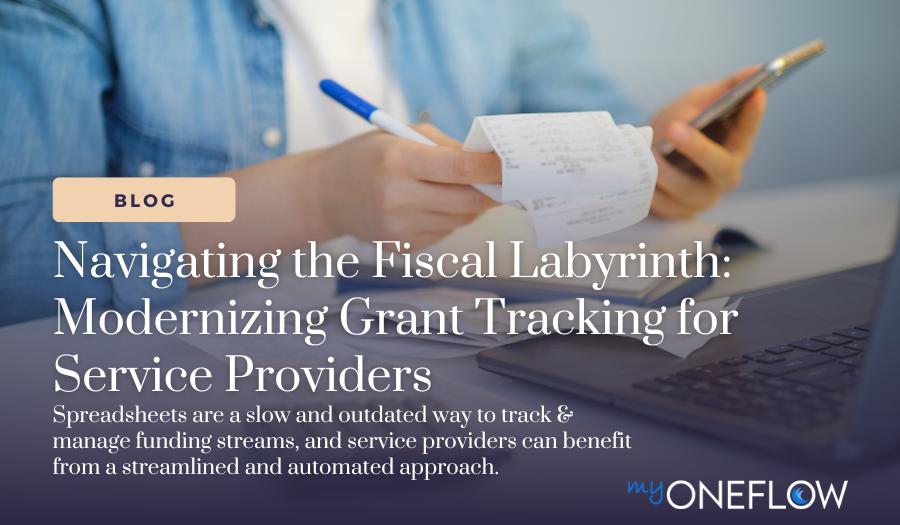4 Signs You Need to Modernize Your WIOA Case Management Solution
In an age of sleek software, automated processes, and personalized workflows, we expect a certain level of sophistication from our technology. We...
4 min read
myOneFlow Staff Jan 11, 2024 1:38:11 PM

Workforce development and adult education service providers frequently grapple with the intricate task of fiscal and grant tracking. Juggling funds from various federal, state, and local sources while adhering to specific requirements can be challenging and error-prone, especially when managed manually. Given the challenges that arise from these obstacles, it is crucial to simplify these procedures. An efficient, well-organized system for tracking funds can significantly reduce manual effort, minimize errors, and save considerable time. More importantly, it allows organizations to refocus their energy on what truly matters - delivering quality workforce development and adult education services. This blog explores the path towards streamlined processes, offering practical advice from industry best practices and expert insights.
In many organizations, fiscal and grant tracking is still a manual process. Spreadsheet software like Microsoft Excel is frequently the tool of choice. These spreadsheets are often meticulously designed with individual cells representing different funding sources and expenditures. As funds are received and spent, data entry is performed manually, with each transaction recorded line by line. While familiar and straightforward, this method relies heavily on the accuracy and diligence of the person managing it.
This process is not without its challenges. For one, it is labor-intensive and time-consuming, requiring constant attention and management. Moreover, the risk of human error is high. An incorrect entry can throw off an entire budget, leading to significant discrepancies. Furthermore, spreadsheets lack sophisticated auditing capabilities, making identifying and correcting errors difficult. The absence of real-time updates and automated alerts also means that potential issues may not be identified until they have already caused problems.
The limitations of manual tracking become more pronounced as the scale and complexity of operations increase. In addition to being labor-intensive and prone to errors, manual methods lack flexibility. They struggle to accommodate changes in funding sources, allocation rules, or reporting requirements. Furthermore, manual systems typically lack robust reporting features, making it challenging to generate comprehensive financial reports or conduct in-depth analyses. The lack of automation also means that routine tasks, such as reconciling budgets or updating financial projections, must be done manually - a time-consuming and error-prone process.
To illustrate the challenges of manual tracking, consider a real-world scenario. An organization providing adult education services receives funding from various sources - federal grants, state subsidies, and private donations. Each funding source has its own set of rules for how funds can be spent and requires separate financial reports. Managing this manually is not just tedious but also risky. An incorrect allocation of funds or a mistake in a financial report could lead to penalties, loss of funding, or damage to the organization's reputation. This example underscores the need for a more efficient, reliable fiscal and grant tracking system.
Leading organizations are moving away from manual processes and embracing technology to improve their fiscal and grant tracking. One best practice is the use of integrated fiscal tracking platforms. These systems consolidate all financial data into a single platform, eliminating the need for multiple spreadsheets and manual data entry. They also provide real-time updates, ensuring that organizations have accurate, up-to-date information at their fingertips.
Another best practice is automation. Organizations can save time, reduce errors, and focus on more strategic activities by automating routine tasks like data entry and report generation. Lastly, successful organizations regularly review and update their financial processes, proactively identifying and addressing inefficiencies.
Improving fiscal and grant tracking begins with a thorough review of current processes. Identify areas where errors frequently occur or where too much time is spent. Consider how these processes could be simplified or automated. Next, invest in training for staff members. Ensuring everyone understands the importance of accurate fiscal tracking and how to use the tools and systems in place is critical. Finally, consider seeking external help. Consultants or software providers specializing in financial management for service providers can provide valuable insights and support.
Transitioning from manual methods to more modern approaches can bring numerous benefits. First and foremost, it can significantly reduce the time and effort required for fiscal and grant tracking. Automated systems can handle many tasks previously done manually, freeing up staff to focus on other aspects of their work. Moreover, modern systems are typically more accurate and reliable than manual methods, reducing the risk of errors and discrepancies. They also provide better visibility into an organization's financial status, making it easier to make informed decisions. Finally, modern systems can adapt more quickly to changes in funding sources or reporting requirements, ensuring that organizations remain compliant and avoid penalties.
myOneFlow is an end-to-end grant management solution that meets the unique needs of service providers, including public agencies, workforce organizations, and education providers. myOneFlow offers a transparent, closed-loop process by connecting grantors, grantees, and participants. Its AI-powered workflows keep all parties connected throughout the grant lifecycle, allowing for effortless tracking at every stage, even down to the subgrantee level. With a built-in suite of advanced and custom reporting tools, myOneFlow simplifies compliance with state and grantor reporting requirements. Plus, it can integrate with many accounting software programs, making gaining a holistic view of your organization's spending more accessible. The platform's configurability and unified approach to grant management make it an ideal choice for service providers seeking to modernize their fiscal and grant-tracking processes.
Effective fiscal and grant tracking is essential to any successful service-providing organization. It ensures financial accountability, facilitates compliance with funding requirements, and provides critical insights for decision-making. However, traditional manual methods are fraught with challenges - they are time-consuming, prone to errors, and lack the flexibility needed in today's dynamic environment. Organizations can improve accuracy, increase efficiency, and free up resources to focus on their core mission by transitioning from manual to modern methods.
Whether adopting industry best practices, investing in staff training, or implementing a comprehensive solution like myOneFlow, there are numerous ways to improve your fiscal and grant tracking processes. Remember, the goal is not just to manage your funds better but to enable your organization to thrive. If your organization could benefit from a more modern approach to fiscal tracking, contact our team today to discuss your options.

In an age of sleek software, automated processes, and personalized workflows, we expect a certain level of sophistication from our technology. We...
.png)
Data reporting and compliance have become increasingly complex for public service programs relying on multiple funding streams. Many organizations...

The U.S. Department of Labor recently released a new Training and Employment Guidance Letter (TEGL), TEGL 03:23, to provide workforce agencies and...